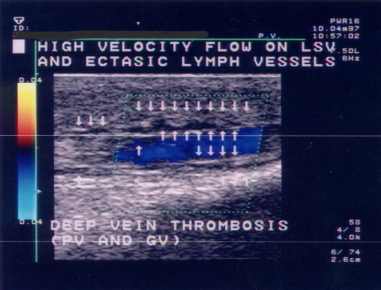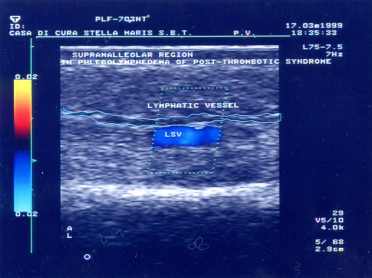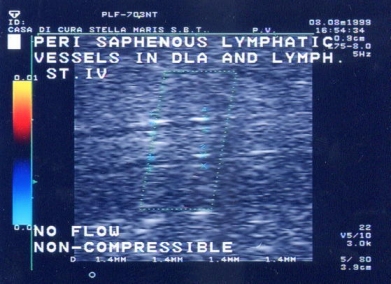

A.Cavezzi
Abstr.Book XIII World Congress of Phlebology, Sydney Sept. 1998, pag 213
The diagnosis of upper and lower
limb lymphedema (LYM) currently relies upon the clinical approach and upon lymphoscintigraphy
in selective cases. Echo-colour-doppler (ECD) is a very reliable method for
arterial and venous investigation. The recent exploitation of this technology
for lymphatic disorders enables us to gather further complementary information.
High frequency (10 MHz or more)ECD probes allow a detailed, although improvable,
study of the lymphedematous tissues, regarding both quali-quantitative aspects
of the supra-sub-fascial fluid accumulation, and the changes of the layer's
structures (degree of fibrosis, "empty" spaces after therapy, etc.) Similarly,
ectatic lymphatic vessels and especially limphoadenopathies may be visualized,
as well as any neoformation (haematoma, cyst, and so on). It is also adequately
possible to monitor the LYM evolution and the therapeutic results by means of
repeated measurements
ECD examination may also detect any venous (coexisting?) disorder with great
accuracy; furthermore it is also necessary and sufficient for most of the differential
diagnoses of swollen limb (i.g. deep venous thrombosis (DVT), angiodysplasia,
post-thrombotic syndrome (PTS).
Recent applications of this method seem to enhance the comprehension of the
relationship between lymphatic and venous system in the pathophysiology of edema:
a) venous calibers seem increased for lymphedematous limb in 89% of the patients
(even more in case of dermatolymphangioadenitis),b) the subclavian-axillary
venous obstacled discharge (or obstruction) is often present in the post-mastectomy
large arm, c) the lymphatic compartecipation is evident in acute DVT or advanced
PTS, d) finally during the LYM therapeutical sessions, ECD may guide manual
lymphatic drainage and associated combined physical treatments.
We have been performing ECD in lymphedematous extremities for more than 6 years,
combining this instrumental method with an integrated and holistic treatment
(mainly physical-rehabilitative) in about 400 patients, obtaining a "synergic"
diagnostic-therapeutical approach.
Conclusions: Although conditioned by technical limits, the non-invasive and
reproducible ECD diagnostics is able to provide precious data to improve the
management of LYM and useful information for lymphological scientifical
studies.




 Home Page |